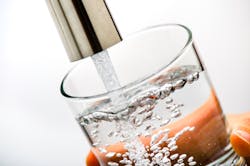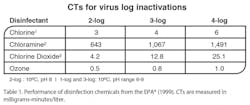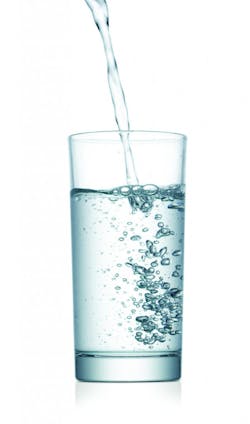Professor POU/POE: Chloramines in water
Q: Why are chloramines used to treat drinking water? What concerns exist about using them?
A: Inorganic chloramines are increasingly chosen as secondary disinfectant treatments for drinking water in municipal water systems because they are less chemically reactive than free chlorine. They produce fewer disinfection byproducts than chlorine, and they survive longer during drinking water distribution to consumers.
Chloramines are a generic chemical family of compounds that consist of amine nitrogen bound to chlorine. Those of interest in water are inorganic chloramines and organic chloramines. They are also chemical intermediates in the production of other chemicals and rapidly form on-site in water by reacting some form of ammonia or amine, including ammonium salts, with active chlorine or hypochlorite. Amides and proteins will also N-chlorinate.Product distributions are determined by the ratio of chlorine and ammonia, pH, temperature and the order of addition. The double arrow in the reactions (shown below left)means that the reactants and products are in equilibrium, so a very small amount of free chlorine will be present depending on the conditions and could be the functioning disinfectant. The predominant product is NH2Cl (monochloramine) at a chlorine-to-ammonia weight ratio up to about 5:1, which is about one molecule of Cl2 to one molecule of ammonia, and pH of about 7 to 9. Monochloramine, the desired product, is stable in that range. The di- and tri-chloramines are undesirable because they are more volatile and irritating and are much poorer disinfectants than monochloramine. Therefore, it is always important to optimize conditions to produce monochloramine.
Organic N-chloramines are also undesirable in water because they are less effective disinfectants, and they can produce additional tastes and other disinfection byproducts (DBP). Source waters usually contain organic nitrogen that reacts with chlorine to produce chloramines and chloramides. If the chlorine dose is sufficient to react with and oxidize all the ammonia and reactive organic nitrogen present, the water will achieve breakpoint, and additional chlorine will become available chlorine. If breakpoint is not reached, N-chloramines will remain as combined chlorine. The latter can occur in drinking water treatment and almost always is present in wastewater treatment because the ammonia and organic nitrogen are found in greater concentrations than in drinking water source water. Chloramines, including trichloramine, are also formed in swimming pools that are chlorinated because of the high levels of organic nitrogen chemicals supplied by the swimmers and the heavy chlorine dosage.
Monochloramine in water disinfection
Deliberate use of chloramines in water treatment dates back around 100 years. Chloramines’ primary application as secondary disinfectants comes in drinking water. Primary disinfectants include chlorine, chlorine dioxide, ozone and UV light. Primary disinfectants are potent biocides that can destroy pathogens in the water treatment plant so the water entering the distribution system is microbiologically safe. Secondary disinfectants reduce regrowth of microorganisms during the transit of the treated drinking water to consumers. The objective method of comparing the efficacy of disinfectants is the CT that quantifies the die off as log reductions at a given temperature and pH, by the product of the concentration (C) in milligrams per liter, and the time (T) in minutes (see Table 1). Smaller values indicate greater efficacy for each level of log inactivation.
However, chloramine may have other benefits compared to more potent and chemically active disinfectants by suppressing growth of biofilms that are a likely environment for colonization by pathogens such as Legionella bacteria. After San Francisco switched from free chlorine to combined chlorine residuals in 2004, Legionella detections in hot water systems were reduced from 60 to 4 percent. Possible explanations include that the free chlorine residual was not able to survive throughout the system or that chloramine was more capable of penetrating biofilms to reach the microorganisms because it was less chemically reactive to the biofilm and more hydrophobic than hypochlorite ion.
Health issues
The application of chloramines as a secondary disinfectant in treated drinking water has been increasing since the U.S. Environmental Protection Agency (EPA) updated regulations for DBP total trihalomethanes (TTHM) and haloacetic acids (HAAs). The original TTHM regulations in 1979 initiated the activity, which was increased with the addition of HAAs and the new restrictions and lower TTHM MCLs in 1998 and tightened compliance computation requirements in 2006. All of these increased the numbers of water systems likely to be out of compliance with TTHMs or HAAs and led many to change to the chloramine approach. A more expensive alternative treatment would be to reduce the precursor organic carbon content of the water with membranes before application of the disinfectant, or removing the DBPs with granular activated carbon after formation.
Monchloramine produces fewer DBPs than chlorine, but their nature is also different. Some of the same DBPs are produced, but less halogenation and oxidation of organic carbon in the water will occur because of the lower chemical activity of monochloramine. Other chemicals such as dimethylnitrosamine and chlorinated quinones may be present at parts per trillion concentrations, especially from surface waters that have more precursors present. A greater opportunity for nitrate/nitrite to form is present during water distribution in systems with longer retention times. It is not known whether water is chemically safer with chlorine DBPs or chloramine DBPs. The risk from chlorinated drinking water has not yet been completely determined after about 37 years since the first TTHM regulation, and less information is available on chloraminated drinking water.
julichka/iStock
Water analyses
Several low cost analyses for total chlorine aggregate free and combined forms exist. Using methods that will provide values for each component is important. EPA-approved methods include amperometric titration method Standard Method 4500-Cl D, and DPD Methods 4500-Cl F (ferrous titration) and 4500-Cl G (colormetric).
Regulations
Apart from the DBP regulations that impact the applications of chloramines and free chlorine, the EPA has also produced maximum residual disinfectant level (MRDL) regulations for chlorine (4 milligrams per liter (mg/L)), chloramines (4 mg/L) and chlorine dioxide (0.8 mg/L) based on high longer term dose exposures in test animals. The logic for the toxicological bases of the MRDLs for human exposure from drinking water is somewhat weak because the chemicals disappear after reacting with saliva and stomach acid.
Monochloramine is less stable at a pH below 3 to 4. Studies with chloramines in gastric fluids (typical pH 1 or 2) reported disappearance of monochloramine and no detection of dichloramine or trichloramine in less than 30 seconds. However, the MRDL values for chlorine and chloramines have virtually no impact on water treatment practices because residuals of 4 mg/L are unusual; typical levels are in the 1 to 2 mg/L range. They may impact reducing taste and odor complaints, although the taste thresholds for both free chlorine and chloramines are less than 1 mg/L and the chloramines are less noticeable
than chlorine.
Several devices can remove chloramines from drinking water if desired. These include point of use and point of entry devices with sufficient granular activated carbon or reverse osmosis and certified to ANSI/NSF Standard 42 or Standard 60, and also UV systems.
Concerns
Chloramines, like other usually innocuous drinking water components such as nitrate, are harmful to kidney dialysis patients if the water is not properly pretreated. During dialysis, direct transport from water to blood occurs, which is a very different exposure condition than ingestion. Cases of hemolytic anemias and increased methemoglobin have occurred when chloramine was not sufficiently removed from the dialysis water. Medical instrumentation standards exist, and dialysis systems designed with water treatment make the water acceptable usually with reverse osmosis in the treatment train.
Fish are particularly sensitive to both chlorine and chloramines, so tank water must be properly pretreated to remove them. Chloramines are more difficult to remove than free chlorine, so effective technology must be applied. Treatment is especially important during transitions from free chlorine to chloraminated water in public water supplies because the tank water pretreatment will probably need to be upgraded.
Swimming pool water will purge chloramines, particularly trichloramine, and indoor pools may not be sufficiently vented to maintain good air quality. Respiratory and ocular irritations and risks to asthma sufferers are also possible, so proper air quality control of indoor pools is important.
About 15 years ago in Washington, D.C., switching from free chlorine to chloramine residuals resulted in water chemistry changes that released more lead from lead service lines, exceeding the Lead and Copper Rule Action Level. The addition of a few milligrams of phosphate resolved the problem by passivating the exposed
lead surfaces.
Some people are opposed to drinking water chloramination because of their concerns with potential allergic reactions and skin irritation. If this did occur, it would be in very low incidence.
Summary
Chloramine treatment of drinking water as a secondary disinfectant is increasing to help water suppliers meet THM and HAA regulations. Monochloramine is low cost and effective because it is less chemically reactive than free chlorine and produces fewer, different DBPs. DBPs and chloramines are present in larger amounts in swimming pools and hot tubs where their volatility and air concentrations in indoor areas can be a respiratory problem. Chloramines must be removed from fish tanks and water used in kidney dialysis by pretreatment. They can be removed in home tap water, if desired, but their long use history belies some of the concerns that have been expressed.
Dr. Joe Cotruvo is president of Joseph Cotruvo and Associates, LLC, Water, Environment and Public Health Consultants. He is a former director of the EPA Drinking Water Standards Division.



